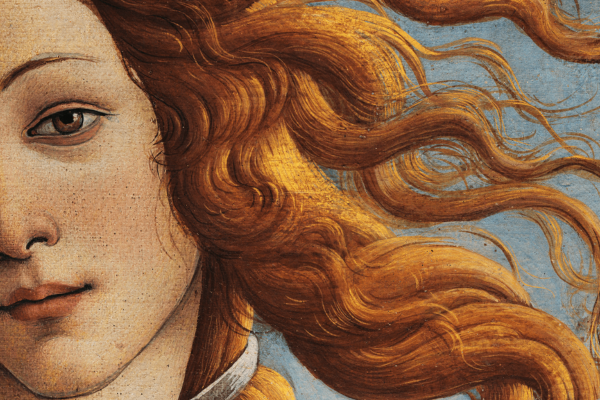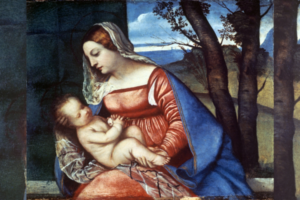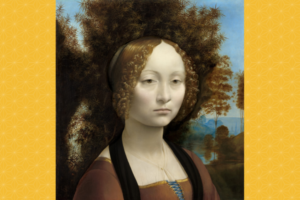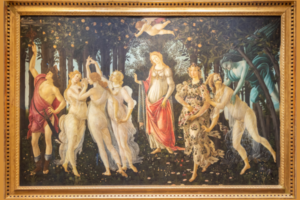The Italian Renaissance, spanning roughly from the 14th to the late 16th century, was a period of immense cultural and intellectual fervor that forever changed the course of Western art and thought. It was a time of rebirth, aptly termed ‘Renaissance’, which means ‘rebirth’ in French, signifying a renewal of interest in the knowledge and artistic ideals of classical antiquity.
Italy, with its rich tapestry of history dating back to the Roman Empire, provided fertile ground for this cultural rejuvenation. As the heartland of the Roman Empire, Italy was densely packed with ruins, statues, coins, and texts that bore witness to the bygone glories of ancient civilizations. Beyond mere admiration for the past, the burgeoning urban centers, prosperous merchant class, and rise of humanism in Italy fostered conditions ripe for innovative art and thought.
Among the many luminaries of this era, artists like Leonardo da Vinci, Raphael, and Titian elevated art to unprecedented heights. Yet, two names frequently stand out when one mentions the Italian Renaissance: Sandro Botticelli and Michelangelo Buonarroti. Botticelli, with his ethereal and graceful figures, and Michelangelo, whose works evoke immense power and grandeur, captured the spirit and essence of the Renaissance in ways few others could. Their contributions, along with those of their peers, laid the foundation for centuries of artistic exploration and marvel.
In the pages that follow, we journey through the vibrant lanes of Renaissance Italy, exploring the incredible tapestry of art and innovation that unfolded, and understanding the indelible marks left by masters like Botticelli and Michelangelo.
Historical Background
The Italian Renaissance, while a distinctly vibrant period, didn’t emerge in a vacuum. Instead, it was the product of a confluence of historical events, societal shifts, and intellectual movements that spanned over centuries. To truly grasp its essence, it’s essential to traverse its timeline and the milieu that fostered its birth.
Timeline of the Italian Renaissance
Late 13th Century: The seeds of the Renaissance began to sprout in the heart of Italy. The city-states, particularly Florence, experienced a surge in trade and banking. This economic prosperity set the stage for an influx of art and knowledge.
14th Century: Often referred to as the Trecento, this century witnessed early sparks of the Renaissance. Writers like Dante Alighieri and Petrarch revived classical literature, blending it with their contemporary experiences. Art started its shift too, with Giotto leading the way towards more naturalistic depictions.
15th Century: Known as the Quattrocento, this period saw the full blossoming of Renaissance art and thought. Linear perspective in painting was perfected, bringing a newfound depth and realism to canvases. Intellectuals such as Erasmus and Pico della Mirandola championed humanistic thought.
Late 16th Century: Termed the Cinquecento, this era was the grand culmination of the Renaissance. The High Renaissance period, spanning from 1495 to 1527, produced some of the most iconic artworks known to humanity, from Leonardo’s “Mona Lisa” to Michelangelo’s Sistine Chapel ceiling.
Social and Cultural Catalysts of the Renaissance
Humanism: This intellectual movement emphasized the value of individual experience and wisdom. Rather than focusing solely on religious texts, humanists sought knowledge from classical Greek and Roman texts, rekindling an interest in history, philosophy, and art.
Economic Prosperity: The growth of trade and the establishment of a banking system, especially in Florence, injected wealth into the Italian city-states. Wealthy patrons like the Medici family funded the arts, allowing artists to push boundaries and innovate.
Political Climate: The fragmented political nature of Italy, composed of competitive city-states, created an environment where art was often used to express civic pride, religious devotion, and showcase the prestige of patrons.
Rediscovery of Classical Antiquity: Ruins, statues, and texts from ancient Greece and Rome served as inspiration. This direct link to the past spurred a renewed interest in the techniques, styles, and subjects of classical art.
Technological Advancements: Innovations such as the invention of the printing press by Johannes Gutenberg around 1440 played a crucial role. It allowed for the widespread dissemination of knowledge, including classical works and contemporary Renaissance thought.
Religious Changes: While Italy remained largely Catholic during this period, there was a burgeoning movement towards personal religiosity and spirituality. Art often became a medium to bridge the gap between the divine and the mortal, leading to masterpieces that were both religiously profound and artistically groundbreaking.
In essence, the Italian Renaissance was more than just a period of artistic growth; it was a cultural revolution. The canvases and frescoes from this era tell tales of societal change, fervent intellectual curiosity, and a relentless pursuit of aesthetic perfection.
Sandro Botticelli (c. 1445 – 1510)
Sandro Botticelli, born Alessandro di Mariano di Vanni Filipepi, stands as one of the luminous figures of the Italian Renaissance. His works, characterized by their ethereal beauty and lyrical quality, are emblematic of the Florentine school of art during the latter half of the 15th century.
Brief Biography
Born in Florence around 1445, Botticelli’s journey into the world of art began as an apprentice to a goldsmith. Later, he trained under the tutelage of Fra Filippo Lippi, a prominent painter of the time. This grounding gave Botticelli a firm foundation in the techniques and styles that were prevalent during his era. By the 1470s, his workshop was one of the most esteemed in Florence, and he enjoyed the patronage of the influential Medici family.
Style and Distinctive Elements of Botticelli’s Paintings
Elongated Figures: Botticelli’s subjects, whether divine or mortal, are often characterized by their elongated necks, limbs, and torsos, lending them a graceful, almost otherworldly presence.
Fluid Lines: The contours in Botticelli’s works are soft, flowing, and rhythmic, giving his paintings a lyrical quality.
Classical Themes: He frequently drew upon classical mythology, marrying pagan themes with Christian iconography, which was a hallmark of Renaissance humanism.
Vivid Detailing: Whether depicting the texture of fabrics or the delicate petals of a flower, Botticelli’s attention to detail is meticulous.
Narrative Depth: His paintings often weave intricate tales, with each character, gesture, and object playing a role in the storytelling.
Key Works
“The Birth of Venus”: Arguably one of the most recognized paintings in the world, this masterpiece showcases Venus, the goddess of love, emerging from the sea on a shell. The wind gods Zephyr and Aura blow her towards the shore, where a nymph awaits with a cloak. The painting is a symphony of delicate colors, harmonious proportions, and fluid lines.
“Primavera”: Another ode to classical mythology, this painting is a visual feast of figures from ancient tales set against a backdrop of a blooming grove. The central figure, Venus, is surrounded by other mythological entities, each representing different aspects of spring.
“Adoration of the Magi”: Commissioned by the Medici family, this religious work captures the moment the Three Kings present gifts to the infant Jesus. Notably, the painting includes portraits of the Medici family and possibly a self-portrait of Botticelli.
Legacy and Influence on Subsequent Artists
Botticelli’s influence extended well beyond his lifetime. While his fame waned in the years immediately following his death, a renewed appreciation for his work emerged in the 19th century. The Pre-Raphaelite Brotherhood, a group of English painters, found inspiration in Botticelli’s ethereal depictions and narrative depth. Today, he’s celebrated not just as a master of the Renaissance, but as a visionary whose blend of spirituality, emotion, and classical knowledge continues to inspire artists and art aficionados alike.
Between Botticelli and Michelangelo: Other Renaissance Masters
The Italian Renaissance, while encapsulated in the works of Botticelli and Michelangelo, was far more expansive in its galaxy of luminaries. Many artists, with their distinctive styles and groundbreaking works, were instrumental in shaping this period of cultural rebirth. Three such maestros — Leonardo da Vinci, Raphael, and Titian — each carved their unique niche, bridging the gap between Botticelli’s etherealism and Michelangelo’s grandeur.
Leonardo da Vinci (1452-1519)
Widely regarded as the epitome of the “Renaissance Man”, Leonardo was not just a painter, but also a scientist, mathematician, engineer, inventor, and anatomist.
“The Last Supper”: Painted on the walls of the Convent of Santa Maria delle Grazie in Milan, this fresco captures the moment Jesus announces one among his disciples will betray him. Leonardo’s mastery lies in the play of emotions on each disciple’s face, the intricate details of the setting, and his innovative use of perspective.
“Mona Lisa”: Housed in the Louvre Museum, this portrait is arguably the most recognized painting in the world. Leonardo’s sfumato technique gives the artwork its soft transitions between colors and tones, creating its enigmatic aura. The subtle smile of the lady, whose identity remains a topic of debate, has enchanted viewers for centuries.
Raphael (1483-1520)
Raphael’s brief life was a meteoric blaze of artistic brilliance. His works are characterized by their clarity of form, harmonious composition, and visual achievement of the Neoplatonic ideal of human grandeur.
Vatican Frescoes: Commissioned by Pope Julius II, Raphael adorned the Vatican’s walls with frescoes that showcased his genius. Each room (or stanza) depicts different theological virtues and historical events.
“The School of Athens”: Part of the Vatican frescoes, this masterpiece illustrates the confluence of the world’s greatest philosophers, from Plato and Aristotle at the center to Euclid and Pythagoras. It’s a homage to the wisdom of the ancient world and a testament to the Renaissance’s reverence for classical knowledge.
Titian (c. 1488/1490-1576)
Hailing from the Venetian school, Titian is celebrated for his revolutionary approach to color and form. His paintings exude a dramatic aura, brought to life through his vibrant palette and vigorous brushwork.
“Assumption of the Virgin”: Dominating the altar of the Basilica di Santa Maria Gloriosa dei Frari in Venice, this monumental artwork captures the moment the Virgin Mary ascends to Heaven. The raw emotion, dynamic composition, and resplendent colors make it one of Titian’s defining works.
“Venus of Urbino”: This sensual portrait of a reclining nude is a quintessential representation of the Venetian approach to female portraiture. With its lush textures and soft, glowing light, the painting is as much a celebration of earthly beauty as it is of artistic mastery.
These masters, each with their distinctive styles and innovations, further enriched the vast tapestry of the Italian Renaissance. Their contributions, alongside those of Botticelli and Michelangelo, defined an era of unparalleled artistic fervor, setting the stage for the centuries of art that followed.
Michelangelo Buonarroti (1475 – 1564)
Dubbed “Il Divino” or “The Divine One”, Michelangelo Buonarroti’s genius transcends the confines of time and medium. His indomitable spirit and fervent dedication to his craft have rendered him a titan of the Renaissance, with contributions that echo through the corridors of history.
Brief Biography
Born in the small village of Caprese in 1475, Michelangelo’s passion for art was apparent from a young age. Despite opposition from his family, he embarked on an artistic journey, starting as an apprentice to the painter Domenico Ghirlandaio and later studying sculpture under the guidance of Bertoldo di Giovanni. Florence, the cradle of the Renaissance, nurtured his budding talent, and by his mid-twenties, Michelangelo had already sculpted “Pieta,” a testament to his precocious brilliance.
His Dual Role as Painter and Sculptor
While many recognize Michelangelo primarily for his painted masterpieces, he often referred to himself foremost as a sculptor. His profound understanding of the human form, drawn from his sculpting experiences, deeply influenced his approach to painting. Each figure he painted seemed to possess a sculptural depth and volume, blurring the lines between the two-dimensional canvas and the three-dimensional chisel.
Exploration of Michelangelo’s Approach to Painting
Human Anatomy: His intricate knowledge of the human body, a result of numerous dissections, lent authenticity and precision to his depictions.
Dramatic Poses: Michelangelo’s figures, whether painted or sculpted, are often portrayed in dynamic and complex poses, showcasing tension, movement, and emotion.
Chiaroscuro: He deftly employed the technique of chiaroscuro, the play of light and shadow, to impart volume and depth to his painted figures.
Narrative Depth: Each of Michelangelo’s paintings tells a story, drawing viewers into a realm of divine intervention, human emotion, and profound allegory.
Key Works:
The Sistine Chapel Ceiling: Commissioned by Pope Julius II, this mammoth undertaking lasted four years. The ceiling depicts nine scenes from the Book of Genesis, interspersed with prophets, sibyls, and ignudi. Michelangelo’s prowess is evident in the lifelike figures that seem to move and breathe above the viewers.
“The Last Judgment”: Adorning the altar wall of the Sistine Chapel, this monumental fresco captures the drama of the final judgment. From the resurrected souls rising to the damned descending into hell, the composition is a maelstrom of emotion and divine power.
“The Creation of Adam”: Part of the Sistine Chapel ceiling, this iconic scene portrays God and Adam reaching out to one another, their fingers nearly touching. It encapsulates the moment God imbues life into Adam, and is emblematic of the Renaissance’s blend of religious devotion and appreciation for the human form.
Legacy and His Continued Influence on the World of Art
Michelangelo’s legacy is monumental. His dedication to capturing the perfect form, both in sculpture and on canvas, set new standards in art. His works are not just masterpieces of the Renaissance; they are pivotal landmarks in the annals of art history.
Centuries later, artists still study his oeuvre for inspiration, learning from his techniques and his unwavering pursuit of perfection. Beyond the realm of art, his influence permeates literature, philosophy, and popular culture, cementing his status as one of the most revered figures in human history.
Comparing and Contrasting: Botticelli vs. Michelangelo
Botticelli and Michelangelo, both titans of the Italian Renaissance, have left indelible marks on the tapestry of art history. While their artworks share thematic and cultural intersections, they also possess unique characteristics that reflect their individual perspectives and the epochs in which they lived. By delving into their differences and similarities, we gain insight into the breadth and depth of the Renaissance movement.
Themes and Motifs:
Botticelli: His works often melded religious themes with classical mythology. Paintings like “The Birth of Venus” and “Primavera” draw heavily from pagan narratives while integrating Christian iconography, embodying the humanistic spirit of the Renaissance.
Michelangelo: While he too was influenced by classical antiquity, Michelangelo’s most prominent works are deeply rooted in Christian theology. The Sistine Chapel Ceiling and “The Last Judgment” revolve around biblical stories, exploring the relationship between man and the divine.
Techniques and Materials:
Botticelli: Known for his soft and fluid lines, Botticelli’s technique was more delicate and ethereal. He employed tempera on panel, a common medium of his time, which lent a matte finish and allowed for intricate detailing.
Michelangelo: Michelangelo’s paintings display a more sculptural quality, a testament to his background in sculpture. His frescoes, painted primarily using the buon fresco technique, are characterized by dynamic figures with a profound sense of volume and depth.
Impact on and Reflection of Society:
Botticelli: His artworks, especially those commissioned by the Medici family, often mirrored the intellectual and cultural milieu of Florence. The blending of Christian and pagan elements is symbolic of a society rediscovering classical antiquity while retaining its religious roots.
Michelangelo: His vast religious commissions, particularly in Rome, reflect the Church’s role as a powerful patron of the arts. His works, while deeply personal, also served as propaganda for the Church, reinforcing its spiritual authority during a period of religious upheaval and the onset of the Reformation.
Influence on Subsequent Art Movements:
Botticelli: While Botticelli’s fame waned after his death, there was a resurgence of interest in his works during the 19th century. The Pre-Raphaelites, in particular, were inspired by his ethereal and narrative-rich compositions, seeing in them a purity they sought to emulate.
Michelangelo: Michelangelo’s profound influence is far-reaching. From the immediate followers in the Mannerist movement, who tried to emulate his dynamic style, to later periods like the Baroque, where artists were inspired by his dramatic use of light and shadow, his legacy is pervasive. Even contemporary artists look to his masterpieces for inspiration, drawn to his unparalleled ability to capture human emotion and form.
In conclusion, while both Botticelli and Michelangelo were products of the same vibrant period, their individual contributions highlight the diversity and richness of the Italian Renaissance. Their contrasting styles, themes, and influences serve as a testament to the multifaceted nature of this golden era in art history.
Lesser-known Gems: Other Noteworthy Artists of the Period
The Italian Renaissance, while often associated with its brightest stars, was in fact a constellation of brilliant talents. Beyond the likes of Leonardo, Raphael, and Michelangelo, several artists sculpted the contours of this golden era with their unique styles and pioneering techniques. Among them, Piero della Francesca, Masaccio, and Andrea Mantegna stand out for their invaluable contributions.
Piero della Francesca (c. 1415 – 1492)
Unique Style: Piero’s works are characterized by their serene and monumental figures, precise linear perspective, and luminous, muted palette. He combined mathematical rigor with an innate poetic sensibility.
Notable Works: “The Baptism of Christ” captures his mastery over light, with the crystalline water and pale sky merging seamlessly. His fresco cycle, “The Legend of the True Cross” in Arezzo, is a panoramic narrative showcasing his geometric precision and narrative flair.
Legacy: Often referred to as the “monarch of painting,” Piero’s focus on geometry and perspective deeply influenced subsequent Renaissance painters and theorists.
Masaccio (1401 – 1428)
Unique Style: Despite his brief life, Masaccio’s impact on Renaissance painting is profound. His works are marked by their solid three-dimensionality, chiaroscuro modeling, and emotionally charged figures.
Notable Works: The Brancacci Chapel frescoes, co-painted with Masolino, are often dubbed the “Sistine Chapel of the Early Renaissance.” Scenes such as “The Tribute Money” showcase his innovative use of light and atmospheric perspective.
Legacy: Masaccio’s pioneering techniques became foundational for the next generation of painters. His naturalistic approach to the human form and space set the stage for the High Renaissance.
Andrea Mantegna (c. 1431 – 1506)
Unique Style: Mantegna, a master of perspective and foreshortening, often incorporated archaeological precision in his renderings of classical motifs. His works exude a sculptural quality, a nod to his fascination with sculpture and his close ties with the sculptor Donatello.
Notable Works: “The Dead Christ,” with its dramatic foreshortening, offers viewers an almost tactile experience of Christ’s body. His series of frescoes in the Camera degli Sposi (Bridal Chamber) in Mantua’s Ducal Palace showcases his ability to create illusionistic architectural spaces.
Legacy: Mantegna’s meticulous approach to detail, combined with his love for classical antiquity, made him a seminal figure bridging the Early and High Renaissance periods.
In the grand tapestry of the Renaissance, while figures like Botticelli and Michelangelo may dominate the foreground, it is essential to recognize the intricate threads woven by artists like Piero della Francesca, Masaccio, and Andrea Mantegna. Their works, while perhaps lesser-known to the broader public, are foundational pillars of this epochal movement.
Conclusion
The Italian Renaissance, a luminescent epoch of human achievement, transformed not just the landscape of art, but also the very way we perceive the world around us. Its reverberations, while rooted in the tapestries of 15th and 16th-century Italy, continue to echo in the corridors of contemporary art and thought.
Central to this transformative era were figures like Botticelli and Michelangelo. Their masterpieces, whether they capture the ethereal beauty of Venus emerging from the sea or the divine spark shared between man and creator, encapsulate the Renaissance spirit. A spirit that sought to harmonize classical antiquity’s reverence for proportion and form with the period’s emergent humanistic philosophy. Their works are not just paintings on a canvas or frescoes on a chapel ceiling; they are dialogues—conversations between artist and viewer, spanning centuries, touching on themes of love, divinity, humanity, and beauty.
Yet, it wasn’t just these luminaries that defined the period. As we’ve journeyed deeper into this era, we’ve uncovered a galaxy of artists, each contributing a unique voice to the grand symphony of the Renaissance. From the geometric harmonies of Piero della Francesca to the tactile realism of Andrea Mantegna, these artists, together, painted a portrait of an age that forever shifted the axis of art and culture.
To the discerning reader, our exploration is but a gentle brushstroke on the vast canvas of the Italian Renaissance. Beyond the confines of this article lies a world brimming with stories, innovations, and masterpieces waiting to be rediscovered. Whether you’re wandering through the hallowed halls of the Uffizi Gallery, gazing up at the vaulted ceilings of the Sistine Chapel, or diving into texts that chronicle this golden age, remember that the Italian Renaissance is more than just an era; it’s a testament to humanity’s eternal quest for beauty and understanding.
So, as you stand at this crossroads of history and art, take a moment. Breathe in the legacy, the genius, and the passion of the Italian Renaissance. And let it inspire you, as it has inspired countless souls before, to explore, to learn, and to marvel at the boundless capacities of human creativity.



